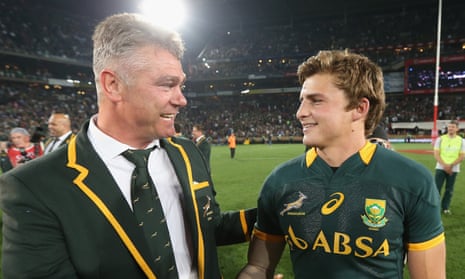A glossy TV advert for the Rugby World Cup shows South African celebrities standing with hand on heart. They include the 1995 winning captain Francois Pienaar (white), team-mate Chester Williams (black), Miss World Rolene Strauss (white), Ladysmith Black Mambazo (black) and comedian Trevor Noah (mixed race).
It is a vision of the rainbow nation at ease with itself. It is also an illusion. Twenty years after the country’s first black president, Nelson Mandela, pulled on the Springboks jersey, then the symbol of white sporting pride, and presented Pienaar with the World Cup in a moment of harmony and hope, the sport remains lacking in racial diversity.
This week the Congress of South African Trade Unions (Cosatu) called for the head coach, Heyneke Meyer, to be sacked, branding him “racist” in his selections after saying it had received complaints from several players.
South Africa have suffered four successive defeats, beaten 37-25 by Argentina at home last weekend. Two black players, Bryan Habana and Tendai Mtawarira, began that match with three more on the bench. Meyer has named his team to face Argentina in Buenos Aires on Saturday, with four black players – Habana, Zane Kirchner, Trevor Nyakane and Lwazi Mvovo – in the 15.
Cosatu, an influential ally of the late Mandela’s governing African National Congress (ANC), warned that Springbok shirts would be burned in protest if “the government allows the old rugby mafia to control a national sport for their own interest”. In addition, the first black Springboks coach, Peter de Villiers, who led the team from 2008 to 2011, criticised Meyer for dropping Cornal Hendricks and playing the white Jesse Kriel out of position against Argentina last weekend. “That decision took the country back to the late eighties, when blacks supported the opposing team because of apartheid,” De Villiers wrote.
Meyer’s response – “I don’t look at colour. I look at the best players” – may have done little to help his case. The defence of colour blindness carries little weight in a highly-racialised society where the black majority were subjugated for more than three centuries by colonialism and apartheid, and where “decolonisation” has become a hot topic at corporate boardrooms and university campuses.
Just as Mandela’s gesture in 1995 was hailed as a metaphor for racial reconciliation in the nation, so rugby’s failure to transform is seen as a metaphor for disillusionment among black people who gained political but not economic freedom.
“A lot of the good things that were done in 1995 were destroyed over the years by wrong decision making,” said Williams, who was the sole black player on the winning team in the final against New Zealand. “We were hoping things would get better and better and more [black] people would come through. More did come through but they were not consistently selected for the team.”
The former winger, now 45, continued: “They give a black player a chance but then they don’t give him another chance to get better. At this stage they give a black player one opportunity and if he doesn’t make it he doesn’t play again. Clearly we can’t only have two black players in the Springbok team. It’s unacceptable.”
In the most recent match against Argentina, Williams complained, a black player was brought on as a substitute with only two minutes left and the game already lost. “That’s window dressing,” he complained.
South Africa won the World Cup again in 2007 with two black players in the team (whites make up about 9% of the South African population). The race debate cropped up before the 2011 tournament and now in 2015, with much soul searching over the teaching of rugby in schools, the role of institutional racism and if racial quotas should be imposed.
Mondli Makhanya, a columnist at City Press newspaper, said: “It’s how we warm up for the World Cup. We have not moved. It’s not because there are not black players. There are black kids at former white schools who are damn good players; a significant number outshine the white players. You hear, ‘He’s a future Springbok’ and then he disappears in the system. Where the blockage is, I don’t know. The rugby authorities should know and should unblock it. It has to change for the sake of normality.” He added: “The making of the national selections also has to change. The white mentality of the corporate world, that the white guy is better, is still there.”
The chaotic, frustrating, wonderful patchwork of South Africa’s democratic compromise is well illustrated by the national anthem, a hybrid combining extracts of the hymn “Nkosi Sikelel’ iAfrika” (God Bless Africa) and “Die Stem van Suid-Afrika” (The Call of South Africa) with new English lyrics. But it doesn’t always work at a Springboks match, Makhanya added.
“The crowd is pretty quiet during ‘Nkosi Sikelel’ iAfrika’ but when they get to “Die Stem”, the roof gets blown off. It tells you a lot. Rugby is the one thing Afrikaners [the descendants of Dutch and German settlers] want to hang on to as their own culturally. Rugby says Afrikaner power.”
There are historical and cultural reasons for the sporting divide. Rugby came to South Africa from England in the 19th century and was adopted by Afrikaners. Black people in townships generally embraced another English import, football, though rugby has a strong black following in Eastern and Western Cape provinces. Steve Biko, the founder of black consciousness, was a flanker, though by all accounts not a good one.
Frans Cronje, chief executive of the Institute of Race Relations thinktank, said: “There is a problem and we think its a problem of rugby development. It’s taken very long for a crop of young black players to appear on the scene who have a chance of Springbok selection. That’s not unexpected if you consider that a relatively small number of high schools produce a large proportion of Springbok players. I think far too little has been done on the part of rugby authorities in the country.”
In areas where black people play rugby the facilities are poor, he added: “The long term solution is to give more black kids at school level more access to the resources and culture that bred so many excellent white Springboks over the last hundred years. If you did give that access, I have no doubt the team would reflect that in the years ahead.”
The country has committed to have non-whites making up half of all domestic and national teams by 2019. The game’s governing body has insisted that its “strategic transformation plan” is not a quota system. It claims that the majority of rugby supporters and players – at schoolboy and club level – in South Africa are black, and 84% of the country’s Under-18s are black.
Former president Thabo Mbeki once asserted that if boosting black representation meant losing games, that would be a price worth paying. But Fikile Mbalula, the sports minister, said: “Imposing quotas was seen as a way to speed-up the process but this has clearly not worked on a sustainable basis.”
“Change has to take place from the ground up and that means it has to start at school and club level. We need to pay particular attention to issues of equity, equality, excellence, access, organisational culture and good corporate governance. The thread hat remains integrally linked to all this, is development. There can be no transformation without development.”
Peter Bruce, a columnist on the Business Day newspaper, agreed that racial quotas are not the answer. “Nobody’s going to back teams that will go out and lose,” he said. “No matter how right it may be, it doesn’t work.”
But commentators note that racial inequality in rugby reflects many other areas of public life in South Africa, where impatience has found expression in the rise of the radical Economic Freedom Fighters party and the #RhodesMustFall protest movement, which led to the removal of a statue of Cecil John Rhodes from the University of Cape Town.
“It’s part of our never ending culture wars,” added Xolela Mangcu, an academic at the university and biographer of Biko. “We resolved the political problem but we never dealt with these issues of representation. This thing is never going to go away as long as the team remains predominantly white.”

